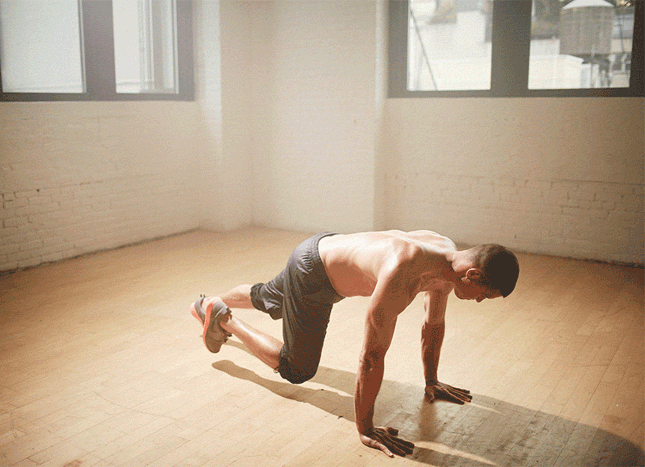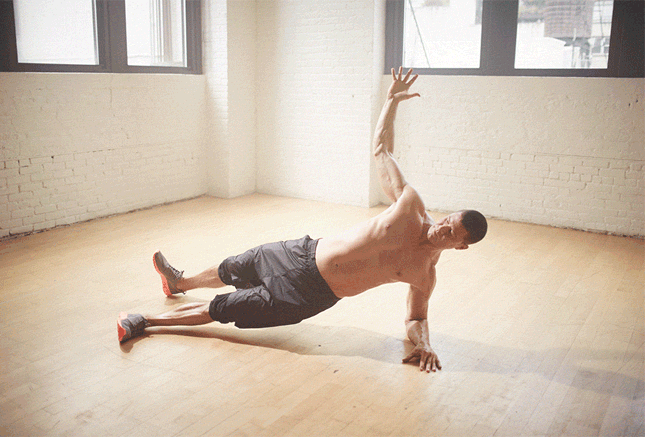Now that the plank has effectively supplanted the crunch as the go-to core-strengthener, exercisers have placed a premium on their ability to hold the toning move -- the longer, the better. As one-minute planks gave way to three-minute planks, and three-minute planks evolved into ten-minute planks, marathon plank-holding has become a calling card of sorts. But, according to Equinox experts, in terms of your fitness progression, it's an exercise in futility, as pointless as cranking out a crazy number of sit-ups.
"Being able to hold a traditional plank for 10 minutes isn't very functional for anything except just that," says Tier 4 trainer Josh Stolz. "Even Stuart McGill (a top authority and researcher of low back pain and function) recommends holding a plank for 10 seconds, tops, followed by a brief, one- to two-seconds-long relaxation of the muscles. This can be repeated a certain number of times, but the point here is that standard planking for a long period of time is not functional because muscles and fascia need to turn on and turn off."
To maximize the move's payoff, you have to get things moving, says Stolz, who uses this four-move series with his clients. "The logic behind these planks is the multi-directional aspect. We move in three different planes of motion in everyday life. For example, when was the last time you got out of bed in a perfectly straight line? You probably rolled to the side, and pushed yourself up with an elbow. The body is designed to function synergistically to conserve energy and allow us freedom of movement."
Plank With Leg Flexion and Extension

Get into standard plank position, hands directly beneath shoulders, but lift right leg off of floor. Drive right knee towards hands, then drive right heel towards ceiling, forming an upside-down V with your body, keeping a straight line from heel to your head. Do 3 to 5 reps; switch legs and repeat.

Get into standard plank position, hands directly beneath shoulders, but lift right leg off of floor. Drive right knee towards hands, then drive right heel towards ceiling, forming an upside-down V with your body, keeping a straight line from heel to your head. Do 3 to 5 reps; switch legs and repeat.
Plank With Arm Flexion and Extension

Get into standard plank position, hands directly beneath shoulders, and lift right hand off ground. Lower hips towards ground, driving extended right arm forward, then drive hips upwards towards ceiling and drive extended right arm directly behind you, so that feet are flat and head points downwards, forming an upside-down V with your body.
Plank With Arm Rotation

In standard plank position, hands directly beneath shoulders, rotate hips to the right as you bring extended right arm up to shoulder height, then rotate hips to the left as you drive right hand beneath and across your torso. Do 3 to 5 reps; switch arms and repeat.
Instead of preparing you to compete in a plank-holding contest, Stolz's series uses the move to strengthen you in a balanced way, making you fitter for movement not just through exercise, but through the various activities and efforts you make each day. "These planks combine mobility and stability, also known as 'mostability,' to better prepare us for function," says Stolz.
And by incorporating other body parts, Stolz elevates the exercise from core-strengthener to total-body power-endurance move. "I consider these planks a full-body exercise, because I'm moving either my hips, arms or legs and trying to control or stabilize the rest of my body. Of course you feel them in the core, but I have clients who also report feeling it in the glutes, obliques, back and shoulders."
Since each 3-part plank becomes progressively more difficult -- you'll advance from adding hip movement, to adding arm movement, to adding leg movement, then to adding both arm and leg movement -- Stolz advises working them into your regular routine based on your fitness level. "The routine can vary greatly depending on the level of the member," he says. "For many of my clients, I use the planks as either a warm-up or activation, or I throw it right into the workout as part of a circuit. These can be done every day, but it's important to know where to start."
Photography by Photography by Mike Rosenthal; Photo Directior & Stylist: Ashley Martin; Grooming: Clelia Bergonzoli
No comments:
Post a Comment